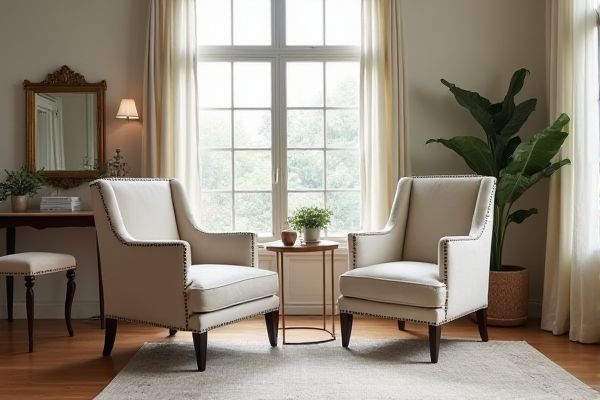
Nailhead trim chairs add a sophisticated, decorative element with metal accents that highlight the furniture's contours, elevating the overall aesthetic and making them a stylish choice for your living space. Discover the key differences and decide which chair best suits your interior design by reading the rest of this article.
Table of Comparison
| Feature | Nailhead Trim Chair | Plain Chair |
|---|---|---|
| Design | Decorative metal nailhead accents outlining the edges | Simple, smooth upholstery without decorative trims |
| Aesthetic Appeal | Elegant, classic, and vintage look | Minimalist and modern look |
| Durability of Edges | Reinforced edges with metal nails for added durability | Standard fabric or material edges prone to wear |
| Cost | Generally higher due to decorative hardware | Usually more affordable |
| Maintenance | Requires occasional cleaning of metal nailheads | Easy to clean, no hardware to maintain |
| Use Case | Ideal for formal settings and traditional decor | Suitable for casual and contemporary settings |
Introduction to Nailhead Trim and Plain Chairs
Nailhead trim chairs feature decorative metal studs along the edges, adding a touch of sophistication and classic charm to furniture designs. Plain chairs, by contrast, emphasize simplicity with smooth, uninterrupted upholstery that suits minimalistic and modern interiors. The choice between nailhead trim and plain chairs depends on the desired aesthetic, balancing detailed craftsmanship against sleek, understated elegance.
Design Aesthetics: Nailhead Trim vs. Plain Styles
Nailhead trim chairs showcase a sophisticated design aesthetic with decorative metal accents that add texture and visual interest, elevating the furniture's overall appeal. Plain chairs offer a minimalist and versatile look, emphasizing clean lines and simplicity that seamlessly fit into various interior styles. Your choice depends on whether you prefer the ornate detail of nailhead trim for a statement piece or the understated elegance of plain chairs for a subtle, timeless design.
Historical Origins and Popularity
Nailhead trim chairs trace their origins to medieval Europe, where metal studs reinforced furniture and added decorative elegance, gaining popularity in the 18th and 19th centuries among aristocratic households. Plain chairs, characterized by their clean lines and absence of embellishments, have roots in early minimalist design movements such as Shaker and Bauhaus, emphasizing functionality and simplicity. Today, nailhead trim chairs remain popular for their classic, ornate appeal in traditional and transitional interiors, while plain chairs dominate modern and contemporary spaces for their sleek, understated style.
Materials and Construction Differences
Nailhead trim chairs feature upholstery secured with decorative metal studs, typically brass or nickel, adding durability and intricate craftsmanship to the frame, often made of solid hardwood. Plain chairs usually employ simpler upholstery techniques such as staples or adhesive without ornamental accents, focusing on minimalist design with frames constructed from engineered wood or less robust materials. The nailhead trim enhances both the aesthetic appeal and structural integrity compared to the more utilitarian construction of plain chairs.
Comfort and Ergonomics Comparison
Nailhead trim chairs often feature reinforced upholstery edges that provide added structural integrity, enhancing long-term comfort compared to plain chairs. Ergonomically, plain chairs may offer simpler designs with fewer pressure points, while nailhead trim chairs emphasize aesthetics without compromising padded support and lumbar alignment. Choosing between the two depends on prioritizing refined aesthetics with durable comfort or straightforward ergonomic functionality.
Versatility in Interior Design
Nailhead trim chairs elevate your interior design with detailed craftsmanship that adds texture and sophistication, making them ideal for both traditional and contemporary spaces. Plain chairs offer simplicity and adaptability, seamlessly blending into minimalist or modern decor while maintaining a clean and uncluttered look. Choosing between nailhead trim and plain chairs depends on whether you want a statement piece or a versatile, understated seating option.
Durability and Maintenance Factors
Nailhead trim chairs feature reinforced upholstery edges with metal studs, enhancing durability by protecting corners from wear and tear, unlike plain chairs that may experience faster fabric fraying. The metal accents in nailhead trim chairs can be easily cleaned and polished, while plain chairs often require routine fabric care such as vacuuming and spot cleaning. Your choice depends on whether you prioritize the long-lasting protection and simple maintenance of nailhead trim or the straightforward upkeep of a plain chair.
Cost Considerations and Value
Nailhead trim chairs often come with a higher price tag due to the added craftsmanship and detailed design elements compared to plain chairs. Your investment in a nailhead trim chair typically reflects enhanced aesthetic appeal and durability, which can increase long-term value and resale potential. Choosing between the two depends on balancing budget constraints with the desire for sophisticated decor and lasting quality.
Choosing the Right Chair for Your Space
Nailhead trim chairs offer a distinctive, decorative edge that enhances the chair's visual appeal, making them ideal for adding sophistication and texture to living rooms or offices. Plain chairs provide a minimalist, versatile design that blends seamlessly with various decor styles and is perfect for creating a clean, understated look. Selecting between nailhead trim and plain chairs depends on the desired aesthetic impact and the room's overall design theme.
Final Thoughts: Making Your Decision
Choosing between a nailhead trim chair and a plain chair depends on your design goals and the ambiance you want to create; nailhead trim chairs offer a sophisticated, decorative edge that enhances classic and transitional interiors. Plain chairs provide a minimalist, versatile look that complements modern and contemporary spaces while maintaining a clean aesthetic. Consider durability, comfort, and how each style aligns with your overall decor theme before making your final decision.
 homyna.com
homyna.com